Over the past few years, high-performance memory kits have evolved in both style and technology. Styling has shifted towards heavier heatsinks, LED light bars and fancy RGB control software. As DDR4 has matured, the technology has done its inevitable, yielding higher speeds and densities at generally lower costs. It's been nearly impossible to get the latest processors and graphics cards for the past six months, but memory prices and availability have held steady, making it the perfect time for Acer to launch its new line of DDR4 memory from its Predator brand. You might recognize the Predator brand from their very successful line of gaming monitors or gaming laptops and desktops. You might even know the brand for the Thanos All-In-One gaming chair.
Acer has dabbled in a variety of gaming products and peripherals. Now, Acer is getting into core hardware with the help of business partner BIWIN Storage , a large Chinese OEM with 25 years of experience in the storage and microelectronics business. Acer has licensed them to make Predator branded memory kits.
The Predator Apollo RGB kit I tested today is one of their top kits: 16 GB (2x 8 GB), 3600 MHz, 14-15-15-35 timing and 1.45 V. 3600 MHz has become the norm for new golden Ryzen builds, shifting new focus to memory kits targeting previously obscure specifications. Let's see how the Predator Apollo RGB performs in this competitive segment!

| Specification | |
| manufacturer: | predator |
| Model: | BL.9BWWR.253 |
| Speed class: | DDR4-3600 |
| Rated time: | 14-15-15-35 |
| Test capacity: | 16 GB (8 GB x2) |
| Test voltage: | 1.45V |
| Types of printed circuit boards: | 10 floors |
| Registered/unbuffered: | unbuffered |
| Error checking: | non-ECC |
| Constituents: | 288-pin DIMM |
| Warranty: | 288-pin DIMM |

The Predator Apollo RGB 3600 MHz is packaged in a sleek black cardboard box in a nicely printed sleeve. The back of the sleeve has most of the elements I'm looking for in a DRAM package, but I wish the specs included voltage.


The memory stick is securely held in place and everything is safe with all but the most careless handling.

The Predator Apollo RGB stick features a two-tone theme and a large RGB diffuser.


The Predator Apollo RGB has a black aluminum heatsink and a large RGB diffuser with silver accents.

"Predator" is printed on the top of each stick.


The specs are 14-15-15-35 timings and a 3600 MHz XMP profile at 1.45 V, which is perfect for a Ryzen based system. "Apollo RGB" is printed in silver on the right side of each stick, next to the Predator logo.


This Predator Apollo RGB 3600 MHz is single sided.

This specification of the Predator Apollo uses a Samsung B-die IC on a 10-layer PCB.


I like to weigh a stick out of every kit I get, as the quality of kits can vary quite a bit. Mass is not the best indicator of cooling efficiency because material matters, and of course heat dissipation depends on surface area, not volume or mass. That said, comparisons are still interesting.
The Predator Apollo RGB is 64.63 g on my scale. For height, the Predator Apollo RGB 3600 MHz on my calipers is 51.73mm thick, slightly above the 45-50mm average.
| test system | |
| processor: | Intel Core i9-10900K 5.3 GHz (Max Boost Clock), 20 MB Cache AMD Ryzen 5 3600X 4.4 GHz (Max Boost Clock), 32 MB Cache |
| cool down: | Custom circuit: Swiftech Apogee SKF LT module, Bitspower SC6 pump and 360 mm radiator |
| motherboard: | MSI MEG Z490 GODLIKE Intel Z490, BIOS P1.30 MSI MEG X570 ACE AMD X570, BIOS 1.80 |
| Graphics card: | EVGA RTX 2080 FTW3 Ultra |
| hard disk: | 2x Crucial MX500 500 GB SATA 6 Gb/s SSD (AMD and Intel OS) 1x Crucial P1 1000 GB NVMe SSD (data) |
| power supply: | Seasonic Prime Titanium 1000 W |
| case: | Primochill Praxis Wetbench |
| software: | Windows 10 Pro 64-bit, NVIDIA GeForce 452.06 WHQL |
Initial setting


The black and silver colors on the Predator Apollo RGB make this kit a perfect combination with other system components.


The RGB lighting is very bright with good diffusion and effects. The Predator Apollo RGB 3600 MHz kit is compatible with several major motherboard RGB software controls, including those from ASUS, ASRock, Gigabyte, and MSI.
Thaiphoon shows that the Apollo kit is using a Samsung B-die IC, and while it claims to be an 8-layer PCB, I've confirmed it has 10 layers.

Intel performance results
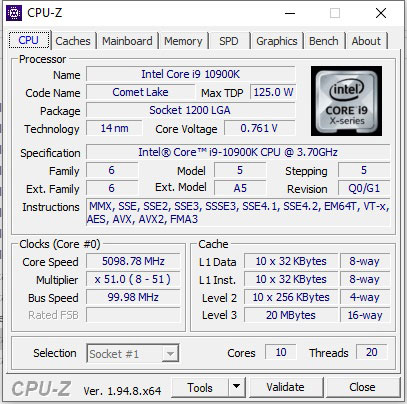



Running the kit at rated speed is as easy as enabling XMP. The Predator Apollo RGB 3600 MHz had no stability issues in my testing.


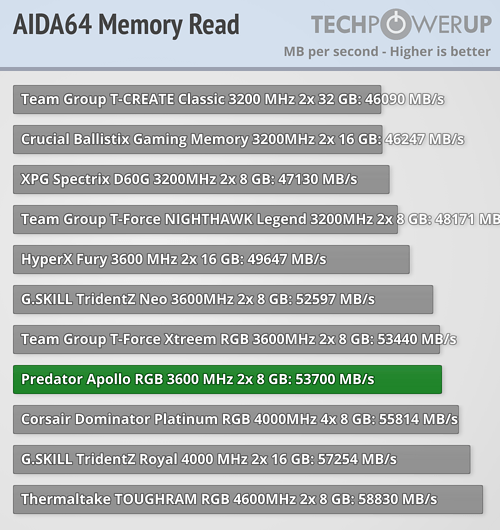

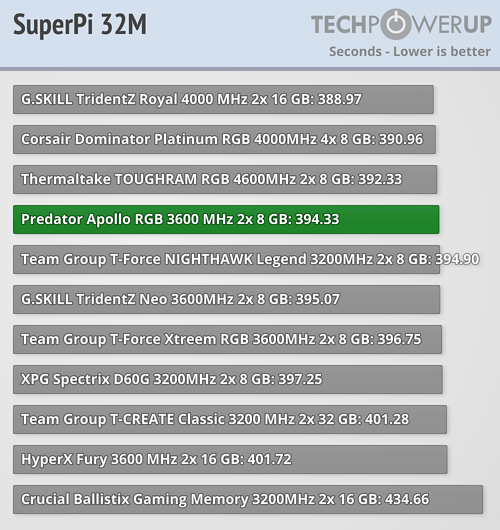








AMD performance results
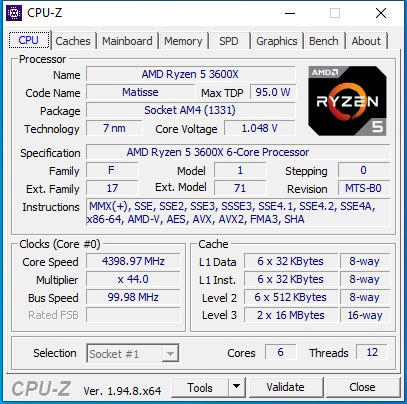






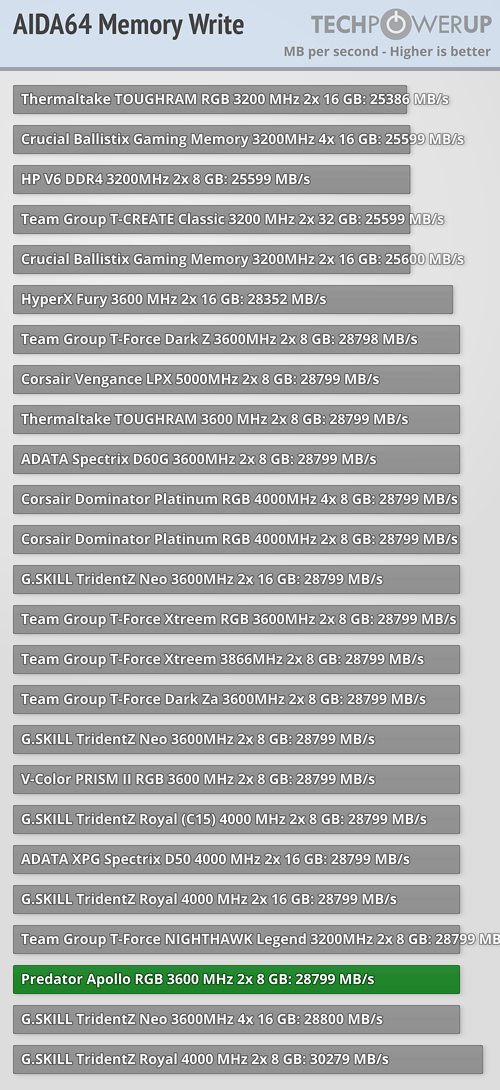



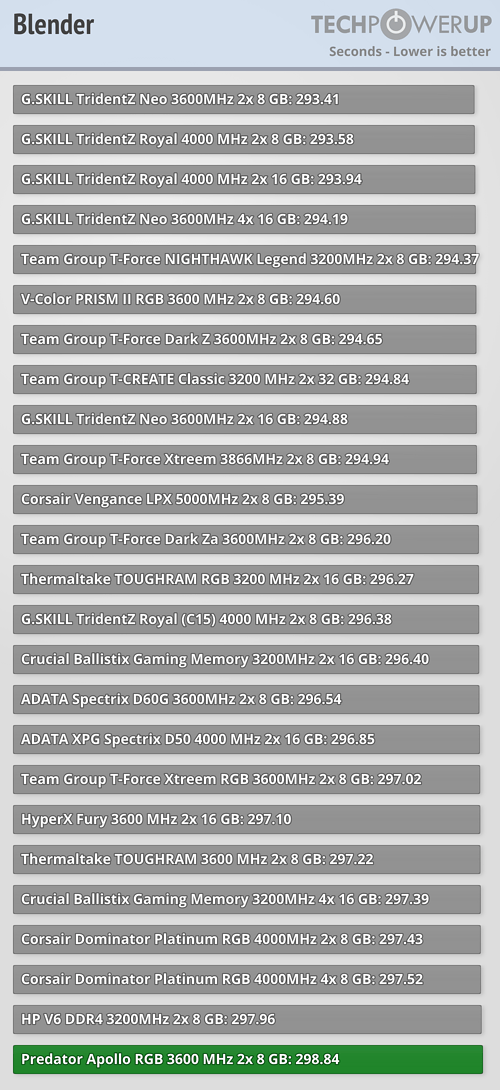






pursuit of speed
Through testing, I struggled to see if the sticks had any headroom. For Intel, I kept the same procedure I've been using, leaving all the settings at the XMP defaults and increasing the frequency until the system lost stability.

I was able to get to 4000 MHz with all other XMP settings default.
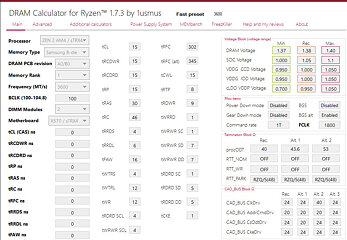

For AMD overclocking, I generally like to dig a little deeper. First, I followed the same procedure as Intel to find the highest frequency for XMP timings. Next, I usually set the frequency to 3600 MHz before using the DRAM Calculator for Ryzen to optimize timings. If the "fast" preset isn't feasible, start with the "safe" setting and try to at least get the main timings as close to the "fast" preset as possible. Then I typically benchmark each setting using AIDA64 to show what kind of benefit you can get from each setting, using the default (non-XMP) settings as a basic reference point.



I was able to achieve 3733 MHz stable with XMP default timings using the Predator Apollo RGB on my MEG X570 ACE. Even better, I was able to use the Fast preset to tighten the timing beyond its XMP level.




Some gains can be made by tweaking the Predator Apollo RGB on Ryzen.
The Predator Apollo RGB is a compelling memory kit. While Apollo uses neutral colors to better match the various builds, the tall profile and bright RGB LEDs make this kit stand out. Aesthetics may diverge, but fit perfectly with other Predator products. The build quality and attention to detail are also excellent, right down to the packaging.
The Predator Apollo RGB performs well at 3600 MHz 14-15-15-35 XMP rating. For overclocking, the Predator Apollo RGB 3600 MHz proved to have a decent amount of headroom, hitting a solid 4000 MHz in my MSI MEG Z490 Godlike and Intel Core i9-10900K combo. Using my MSI MEG X570 ACE and Ryzen 5 3600X test system, the Predator Apollo RGB was able to hit 3733 MHz at XMP timings and remained stable even at the "fast" B-die timing preset.